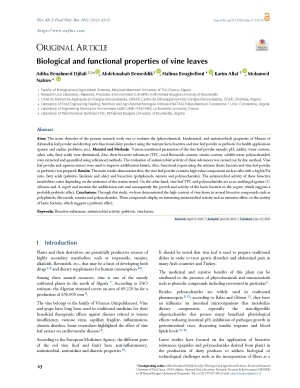Biological and functional properties of vine leaves
Abstract
Aims: The main objective of the present research work was to evaluate the (phytochemical, biochemical, and antimicrobial) properties of Muscat of Alexandria leaf powder and develop new functional dairy product using the mixture lactic bacteria and vine leaf powder as prebiotic for health applications (gastric and cardiac problems, etc.). Material and Methods: Various nutritional parameters of the vine leaf powder namely: pH, acidity, water content, ashes, salts, fatty acid) were determined. Also there bioactive substances (TPC, total flavonoids content, tannin content, soluble-water polysaccharides) were extracted and quantified using referenced methods. The evaluation of antimicrobial activity of these substances was carried out by disc method. Vine leaf powder and aqueous extract were used to improve acidification kinetic. Also functional yogurt using the mixture (lactic bacteria and vine leaf powder as prebiotic) was prepared. Results: The main results demonstrate that, the vine leaf powder contains high-value components such as salts with a high k/Na ratio, fatty acids (palmitic, linolenic and oleic) and bioactives (polyphenols, tannins and polysaccharides). The antimicrobial activity of these bioactive metabolites varies depending on the resistance of the strains tested. On the other hand, vine leaf TPC and polysaccharides act as an antifungal against (C. albicans and A. niger) and increase the acidification rate and consequently the growth and activity of the lactic bacteria in the yogurt, which suggests a probable prebiotic effect. Conclusions: Through this study we have demonstrated the high content of vine leaves in several bioactive compounds such as polyphenols, flavonoids, tannins and polysaccharides. These compounds display an interesting antimicrobial activity and an extensive effect on the activity of lactic bacteria, which suggests a prebiotic effect.
Full text article
Authors
Copyright (c) 2021 Authors

This work is licensed under a Creative Commons Attribution 4.0 International License.
-
Attribution — You must give appropriate credit, provide a link to the license, and indicate if changes were made. You may do so in any reasonable manner, but not in any way that suggests the licensor endorses you or your use.
-
No additional restrictions — You may not apply legal terms or technological measures that legally restrict others from doing anything the license permits.





